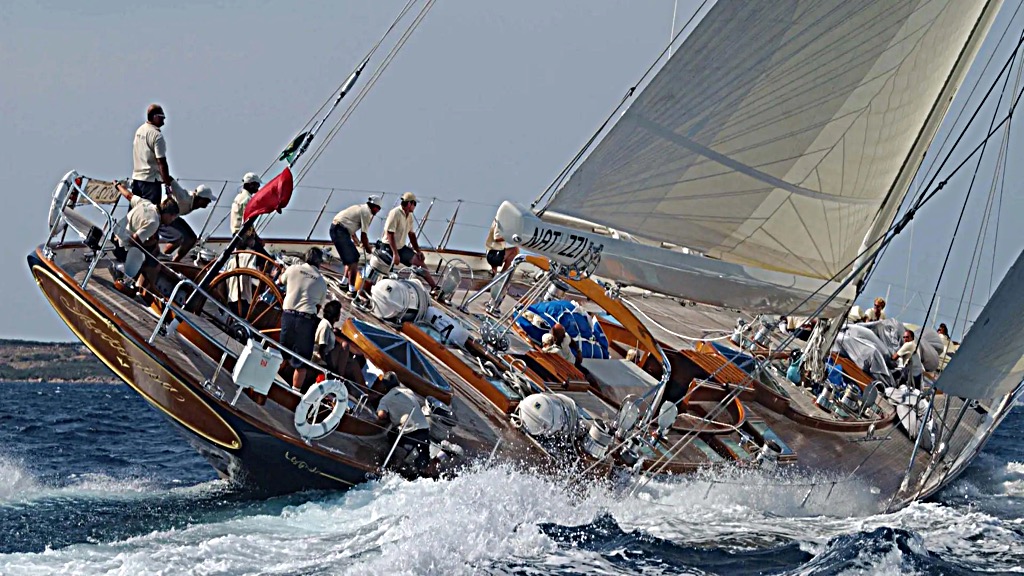
Sail Number:
Vessel Type: Sloop
LOA: 124’0″ / 37.80m – LOD: – LWL: 89’11 / 27.43m – Beam: 25’6” / 7.80m – Draft: 10’0” – 26’6” / 3.00m – 8.10m – Displacement: 159 Tons – Ballast: 106,000 lb – Sail Area: 6,761 sq.ft / 628 sq.m – Hull material: Wood construction – Rig: Sloop – Designer: Bruce King – Built by: Hodgdon Yachts, Maine – Year Built: 1999 – Current Name: Antonisa – Original Owner: Pasquale Natuzzi – Location: Marine Traffic
Historical:
Wanting a larger version of the owners previous yacht “Whitefin”, Natuzzi hired Bruce King Yacht Design, to build a wooden yacht with the same aesthetics, allowing more space to accommodate his crew.
Owned by Italy’s largest furnishing firm, the Natuzzi Group, Antonisa is named after the owners wife. In honour of the owners son, the yacht is adorned with a little star on the stern, Natuzzi used to call his son Stelluccia, (Little Star) when he was small.
The Organ aboard the Antonia
by Rev. Dan Martin – Bruce King set out to design one of the largest sloops ever to be built on these shores. His client, and Italian industrialist, asked for something special. And he got it! To set apart his boat, the Antonisa, Mr. King decided upon a musical instrument to be placed in the main saloon. And not just any instrument, but a ‘real’ pipe organ. Stefan Maier, a European trained organ builder was asked for a design. No mere electronic organ would do here. The challenge was clear. The instrument had to be built in a very limited space. It had to be able to cope with salt air, high humidity, and the rocking and rolling motions of a sailboat at sea. Stefan set to work and was soon able to give Mr. King an outline of such an instrument and the contract was signed.
January of 1998 saw musical interval proportions for the case design and the Golden Means scale chosen for this organ. These were traditions often employed by the German/French organ builder Andreas Silbermann. But here they had to be woven in with the constraints of the interior design of the main saloon of the Antonisa. As the organ’s center coincided with the centerline of the boat, a symmetrical approach was used. To emphasize this, a protruding center pipe, initially embossed with a seashell above the mouth marked the center point of both yacht and organ. The elliptical arc of the case front reflected those of the alcoves in the corners of the saloon. The pipe feet in the center field resembled an anchor. Master craftsman Dimitrios Klitsas of Hampden, Massachussetts, carved the keycheeks in the form of sea scallops.
While the aesthetic features of the organ were important, it was equally important that the instrument be accessible for servicing when required. To this end Stefan used a CAD computer program, which allowed him to see the various parts of the organ from different angles and even evaluate screw placement for best access. In some cases special tools were made to get to hard to reach parts of the organ. Ninety percent of the organ is mechanical. However, in a locker space behind the organ in the galley of the Antonisa, there are 36 pipes placed on a direct electric chest. This chest is removable in case work is needed on the center board of the boat. There are 12 bass pipes of the gedackt 8′ and 22 pipes of the cello. The cello stop is an open string stop made from solid cherry. The combination of the string stop and the flute make for a profound bass sound in the 120 square-foot saloon. The electric chest is driven through a pneumatic-electric action that connects to the channel of the corresponding note on the main chest. In this way the ‘electric’ action and the mechanical action are always perfectly synchronized.
When the instrument was displayed in Mr. Maier’s shop, none of the visiting organists who played it suspected that the organ was not strictly mechanical. And the wind regulator has a spring-loaded vertical plate to ensure that the rocking motion at sea does not result in irregularities in the wind pressure. The pipes are secured in place by special hooks screwed into the rack board should the boat ever roll over. Hodgdon Yachts of East Bothbay, Maine, builders of the boat, supplied Mr. Maier with the cherry wood for the case, bench, and pedal board as well as the wooden pipes.Using the same wood as used in the hull of the Antonisa ensured homogeneity of materials and seaworthy building principals. The interior of the organ, wind chests, wind regulators, keyboard, and pipes were all laminated and coated with epoxy on all exposed surfaces.Seven brushed coats of marine varnish are on all exposed surfaces of both the boat and the organ. Before the organ was installed in the Antonisa, it was set up and tested in the shop of Stefan Maier in Athol, Massachusetts. Organists from the American Guild of Organists were invited to come and play the organ. And come they did-with curiosity. And leave they did-with smiles.

Installation began in the summer of 1998 with each movement being coordinated with the boat builders. Finally the organ case was lowered into place and epoxied to the floor and wall of the boat. The gold-plated hardware of the organ was polished until it matched the glitter of the saloon cabinet’s hardware.
In August of 1999 the proud owner, the builder, the governor of Maine, the organ builder, and about 3,000 people watched the launching of the boat.
The Antonisa left East Boothbay harbor on a cold December day for a shakedown cruise in the Caribbean. She is now birthed in Italy and the organ builder hopes he will soon be called over for a tuning.
Provenance (The Wall of Remembrance – The Owners, Crew & Notable Guest):
Owner: (1999) – Pasquale Natuzzi
